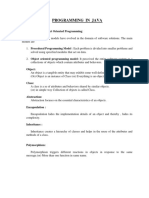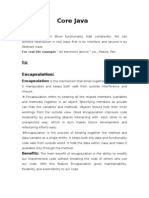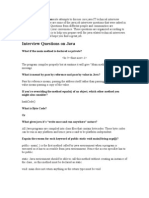Core Java Interview Question
Uploaded by
rizvisa1Core Java Interview Question
Uploaded by
rizvisa1Core Java Interview Question Page 1 Posted on: March 26, 2008 at 12:00 AM
Core Java Interview Question Page 1
Question: How could Java classes direct program messages to the system console, but error messages, say to a file? Answer: The class System has a variable out that represents the standard output, and the variable err that represents the standard error device. By default, they both point at the system console. This how the standard output could be re-directed: Stream st = new Stream(new FileOutputStream("output.txt")); System.setErr(st); System.setOut(st); Question: What's the difference between an interface and an abstract class? Answer: An abstract class may contain code in method bodies, which is not allowed in an interface. With abstract classes, you have to inherit your class from it and Java does not allow multiple inheritance. On the other hand, you can implement multiple interfaces in your class. Question: Why would you use a synchronized block vs. synchronized method? Answer: Synchronized blocks place locks for shorter periods than synchronized methods. Question: Explain the usage of the keyword transient? Answer: This keyword indicates that the value of this member variable does not have to be serialized with the object. When the class will be de-serialized, this variable will be initialized with a default value of its data type (i.e. zero for integers). Question: How can you force garbage collection? Answer: You can't force GC, but could request it by calling System.gc(). JVM does not guarantee that GC will be started immediately. Question: How do you know if an explicit object casting is needed? Answer: If you assign a superclass object to a variable of a subclass's data type, you need to do explicit casting. For example:
Object a; Customer b; b = (Customer) a; When you assign a subclass to a variable having a supeclass type, the casting is performed automatically. Question: What's the difference between the methods sleep() and wait() Answer: The code sleep(1000); puts thread aside for exactly one second. The code wait(1000), causes a wait of up to one second. A thread could stop waiting earlier if it receives the notify() or notifyAll() call. The method wait() is defined in the class Object and the method sleep() is defined in the class Thread. Question: Can you write a Java class that could be used both as an applet as well as an application? Answer: Yes. Add a main() method to the applet. Question: What's the difference between constructors and other methods? Answer: Constructors must have the same name as the class and can not return a value. They are only called once while regular methods could be called many times. Question: Can you call one constructor from another if a class has multiple constructors Answer: Yes. Use this() syntax. Question: Explain the usage of Java packages. Answer: This is a way to organize files when a project consists of multiple modules. It also helps resolve naming conflicts when different packages have classes with the same names. Packages access level also allows you to protect data from being used by the nonauthorized classes. Question: If a class is located in a package, what do you need to change in the OS environment to be able to use it? Answer: You need to add a directory or a jar file that contains the package directories to the CLASSPATH environment variable. Let's say a class Employee belongs to a package com.xyz.hr; and is located in the file c:\dev\com\xyz\hr\Employee.java. In this case, you'd need to add c:\dev to the variable CLASSPATH. If this class contains the method main(), you could test it from a command prompt window as follows: c:\>java com.xyz.hr.Employee
Question: What's the difference between J2SDK 1.5 and J2SDK 5.0? Answer: There's no difference, Sun Microsystems just re-branded this version. Question: What would you use to compare two String variables - the operator == or the method equals()? Answer: I'd use the method equals() to compare the values of the Strings and the == to check if two variables point at the same instance of a String object.
Core Java Interview Question, Interview Question Posted on: April 18, 2011 at 12:00 AM This page discusses - Core Java Interview Question, Interview Question
Core Java Interview Question Page 2
Question: Does it matter in what order catch statements for FileNotFoundException and IOExceptipon are written? Answer: Yes, it does. The FileNoFoundException is inherited from the IOException. Exception's subclasses have to be caught first. Question: Can an inner class declared inside of a method access local variables of this method? Answer: It's possible if these variables are final. Question: What can go wrong if you replace && with & in the following code: String a=null; if (a!=null && a.length()>10) {...} Answer: A single ampersand here would lead to a NullPointerException. Question: What's the main difference between a Vector and an ArrayList Answer: Java Vector class is internally synchronized and ArrayList is not. Question: When should the method invokeLater()be used?
Answer: This method is used to ensure that Swing components are updated through the event-dispatching thread. Question: How can a subclass call a method or a constructor defined in a superclass? Answer: Use the following syntax: super.myMethod(); To call a constructor of the superclass, just write super(); in the first line of the subclass's constructor. For senior-level developers: Question: What's the difference between a queue and a stack? Answer: Stacks works by last-in-first-out rule (LIFO), while queues use the FIFO rule Question: You can create an abstract class that contains only abstract methods. On the other hand, you can create an interface that declares the same methods. So can you use abstract classes instead of interfaces? Answer: Sometimes. But your class may be a descendent of another class and in this case the interface is your only option. Question: What comes to mind when you hear about a young generation in Java? Answer: Garbage collection. Question: What comes to mind when someone mentions a shallow copy in Java? Answer: Object cloning. Question: If you're overriding the method equals() of an object, which other method you might also consider? Answer: hashCode() Question: You are planning to do an indexed search in a list of objects. Which of the two Java collections should you use: ArrayList or LinkedList? Answer: ArrayList Question: How would you make a copy of an entire Java object with its state? Answer: Have this class implement Cloneable interface and call its method clone(). Question: How can you minimize the need of garbage collection and make the memory use more effective?
Answer: Use object pooling and weak object references. Question: There are two classes: A and B. The class B need to inform a class A when some important event has happened. What Java technique would you use to implement it? Answer: If these classes are threads I'd consider notify() or notifyAll(). For regular classes you can use the Observer interface. Question: What access level do you need to specify in the class declaration to ensure that only classes from the same directory can access it? Answer: You do not need to specify any access level, and Java will use a default package access level .
Now lets see what a servlet container does for each HTTP request for a servlet, in general :
The servlet container loads the servlet class and calls the init method of the servlet as soon as the servlet is called for the first time. Then this container makes an instance of javax.servlet.ServletRequest and javax.servlet.ServletResponse for each request. Then it passes the ServletRequest and ServletResponse objects by invoking the servlet's service method. Finally, it calls the destroy method and unload the servlet class when the servlet class is to be shut down.
You might also like
- Java 17 Backend Development: Design backend systems using Spring Boot, Docker, Kafka, Eureka, Redis, and TomcatFrom EverandJava 17 Backend Development: Design backend systems using Spring Boot, Docker, Kafka, Eureka, Redis, and TomcatNo ratings yet
- Java Developers Guide - Capgemini Interview Questions and Answers For Java 3-8 Year ExperienceNo ratings yetJava Developers Guide - Capgemini Interview Questions and Answers For Java 3-8 Year Experience2 pages
- 34 Java Collections Interview QuestionsNo ratings yet34 Java Collections Interview Questions21 pages
- Top 100 Java Interview Questions and Answers 2023No ratings yetTop 100 Java Interview Questions and Answers 202343 pages
- Java Interview Questions: Difference Between Procedure Oriented and Object Oriented Programming Language?No ratings yetJava Interview Questions: Difference Between Procedure Oriented and Object Oriented Programming Language?62 pages
- Java Exception Handling For Certification InterviewsNo ratings yetJava Exception Handling For Certification Interviews42 pages
- Core Java Syllabus: No. Details To Be CoveredNo ratings yetCore Java Syllabus: No. Details To Be Covered3 pages
- Java Interview Questions For 2 Years ExperiencedNo ratings yetJava Interview Questions For 2 Years Experienced8 pages
- 175 16sccit4-16sccca3-16scccs3 2020051602435211 PDFNo ratings yet175 16sccit4-16sccca3-16scccs3 2020051602435211 PDF126 pages
- JDevelopers Guide - IBM Java Interview Questions For 3-8 Year ExperienceNo ratings yetJDevelopers Guide - IBM Java Interview Questions For 3-8 Year Experience3 pages
- Interview Question Collection Framework PDFNo ratings yetInterview Question Collection Framework PDF13 pages
- Full Stack Developer Interview Questions Java 2023 JavatpointNo ratings yetFull Stack Developer Interview Questions Java 2023 Javatpoint2 pages
- Real-Time Encapsulation Interview Questions and AnswersNo ratings yetReal-Time Encapsulation Interview Questions and Answers20 pages
- Java Interview Questions - TutorialspointNo ratings yetJava Interview Questions - Tutorialspoint18 pages
- Advanced Java Interview Questions and AnswersNo ratings yetAdvanced Java Interview Questions and Answers5 pages
- Index of Programs: S. No Program Name Page NoNo ratings yetIndex of Programs: S. No Program Name Page No28 pages
- 1.1 Try With Resources Enahancements PDFNo ratings yet1.1 Try With Resources Enahancements PDF6 pages
- Core Java Interview Questions List - Part I - DZone JavaNo ratings yetCore Java Interview Questions List - Part I - DZone Java10 pages
- Junit - Testing Framework For Java: Types of Unit TestingNo ratings yetJunit - Testing Framework For Java: Types of Unit Testing24 pages
- The Complete Spring Boot: A Comprehensive Guide to Modern Java ApplicationsFrom EverandThe Complete Spring Boot: A Comprehensive Guide to Modern Java ApplicationsNo ratings yet
- Java Fundamentals Made Easy: A Practical Guide with ExamplesFrom EverandJava Fundamentals Made Easy: A Practical Guide with ExamplesNo ratings yet
- Hands-On Microservices with JavaScript: Build scalable web applications with JavaScript, Node.js, and DockerFrom EverandHands-On Microservices with JavaScript: Build scalable web applications with JavaScript, Node.js, and DockerNo ratings yet
- Mastering Java Persistence: From Basics to Expert ProficiencyFrom EverandMastering Java Persistence: From Basics to Expert ProficiencyNo ratings yet
- CNAV-MAN-001.2 (C-NaviGator III Manual) PDFNo ratings yetCNAV-MAN-001.2 (C-NaviGator III Manual) PDF121 pages
- Tribhuwan University: Lab No:..... Sinusoidal OscillatorsNo ratings yetTribhuwan University: Lab No:..... Sinusoidal Oscillators5 pages
- 20091216-153551-APC Smart-UPS 1500VA USB SUA1500INo ratings yet20091216-153551-APC Smart-UPS 1500VA USB SUA1500I4 pages
- Mingw, A Contraction of "Minimalist Gnu For Windows", Is A Minimalist Development Environment For Native Microsoft Windows ApplicationsNo ratings yetMingw, A Contraction of "Minimalist Gnu For Windows", Is A Minimalist Development Environment For Native Microsoft Windows Applications5 pages
- What Is The Relevance of ICT in Your Chosen Course?100% (1)What Is The Relevance of ICT in Your Chosen Course?3 pages
- Introduction To Information Technology: The Future NowNo ratings yetIntroduction To Information Technology: The Future Now47 pages

























































































